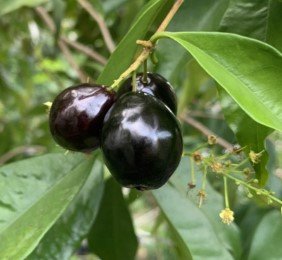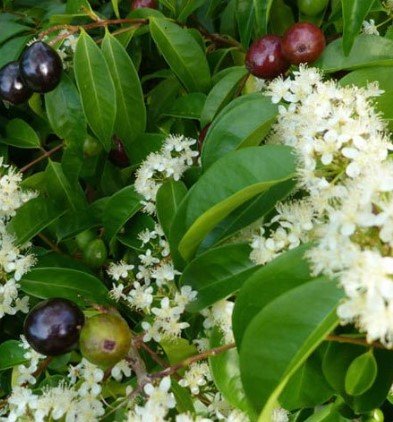 Image 1 of 2
Image 1 of 2

 Image 2 of 2
Image 2 of 2



Raul's Rainforest Plum (Eugenia Candolleana)
Rainforest Plum has small, shiny, dark black fruit that is deliciously sweet and slightly acidic. It produces two crops a year, one in mid-summer and then again in the fall. Our Rainforest Plums are grown from seed and are shrubby trees that can be maintained at 4-6’ tall in containers. It is tolerant of dryness and responds well to pruning making it a good candidate to grow in a large pot. If you keep yours in a pot, it generally begins flowering at 3-4’ tall and benefits from spending the summers outdoors which enhances the pollination. The fruit may be eaten fresh or made into jam.
The fruit has been compared to sabara jaboticaba or grape and is considered by many to be the most flavorful of all eugenia species.
Eugenia candolleana, commonly known as the rainforest plum or milla plum, is a tropical to subtropical species native to regions of South and Central America. It has a reputation for being a relatively hardy evergreen shrub or small tree that produces edible, plum-like fruit. In terms of growing it in New Orleans (USDA hardiness zone 9b), there are a few things to consider.
1. Temperature Tolerance
Eugenia candolleana generally thrives in warm temperatures and can handle some cold, but it’s more sensitive to frost, which could be a concern in Zone 9b during particularly cold winters. In Zone 9b, winters typically dip to around 25–30°F (-3 to -1°C), and while this plant may tolerate short periods of cold down to 28°F (-2°C), prolonged freezing temperatures could damage or kill it.
In New Orleans, winters are usually mild, but occasional cold snaps could harm the plant, especially when young or newly established. If you're growing it outside, providing some frost protection during those rare cold spells (e.g., covering it with frost cloth or moving it to a sheltered area) could help.
2. Sunlight Requirements
Eugenia candolleana prefers full sun to partial shade. In New Orleans, where summers can be very hot and sunny, it's best to plant it in a spot that receives full sun for part of the day, ideally with some afternoon shade to protect it from the harshest sun during the hottest months.
3. Soil and Watering
This species prefers well-drained, slightly acidic to neutral soil. New Orleans typically has heavy clay soils, so you may need to amend the soil with organic matter or plant in raised beds to improve drainage. The plant prefers moist but not waterlogged conditions, so regular watering will be necessary, especially in the summer months, but be careful not to let the roots sit in standing water.
4. Humidity and Rainfall
New Orleans has high humidity, which will actually benefit Eugenia candolleana, as it is adapted to tropical and subtropical climates. This plant will appreciate the moisture in the air and rainfall that New Orleans typically receives, but again, make sure the soil drains well to avoid root rot.
5. Winter Care
In the event of a freeze warning, consider protecting the tree with a frost blanket or bringing young plants into a more sheltered location (such as a greenhouse or covered porch) during the coldest months. Once the tree becomes established, it will be more resilient to the occasional cold snap.
6. Growth Habit and Maintenance
Eugenia candolleana is a relatively slow-growing plant and can be grown as a shrub or small tree, often reaching heights of 10–15 feet (3–5 meters) under ideal conditions. Regular pruning can help keep it manageable if space is a concern.
Conclusion:
Eugenia candolleana can grow in New Orleans Zone 9b with some attention to its needs, especially regarding frost protection during rare cold events. While it will thrive with the humidity, warmth, and moisture typical of New Orleans, ensuring proper drainage and managing occasional cold snaps will be key for its success.
Rainforest Plum has small, shiny, dark black fruit that is deliciously sweet and slightly acidic. It produces two crops a year, one in mid-summer and then again in the fall. Our Rainforest Plums are grown from seed and are shrubby trees that can be maintained at 4-6’ tall in containers. It is tolerant of dryness and responds well to pruning making it a good candidate to grow in a large pot. If you keep yours in a pot, it generally begins flowering at 3-4’ tall and benefits from spending the summers outdoors which enhances the pollination. The fruit may be eaten fresh or made into jam.
The fruit has been compared to sabara jaboticaba or grape and is considered by many to be the most flavorful of all eugenia species.
Eugenia candolleana, commonly known as the rainforest plum or milla plum, is a tropical to subtropical species native to regions of South and Central America. It has a reputation for being a relatively hardy evergreen shrub or small tree that produces edible, plum-like fruit. In terms of growing it in New Orleans (USDA hardiness zone 9b), there are a few things to consider.
1. Temperature Tolerance
Eugenia candolleana generally thrives in warm temperatures and can handle some cold, but it’s more sensitive to frost, which could be a concern in Zone 9b during particularly cold winters. In Zone 9b, winters typically dip to around 25–30°F (-3 to -1°C), and while this plant may tolerate short periods of cold down to 28°F (-2°C), prolonged freezing temperatures could damage or kill it.
In New Orleans, winters are usually mild, but occasional cold snaps could harm the plant, especially when young or newly established. If you're growing it outside, providing some frost protection during those rare cold spells (e.g., covering it with frost cloth or moving it to a sheltered area) could help.
2. Sunlight Requirements
Eugenia candolleana prefers full sun to partial shade. In New Orleans, where summers can be very hot and sunny, it's best to plant it in a spot that receives full sun for part of the day, ideally with some afternoon shade to protect it from the harshest sun during the hottest months.
3. Soil and Watering
This species prefers well-drained, slightly acidic to neutral soil. New Orleans typically has heavy clay soils, so you may need to amend the soil with organic matter or plant in raised beds to improve drainage. The plant prefers moist but not waterlogged conditions, so regular watering will be necessary, especially in the summer months, but be careful not to let the roots sit in standing water.
4. Humidity and Rainfall
New Orleans has high humidity, which will actually benefit Eugenia candolleana, as it is adapted to tropical and subtropical climates. This plant will appreciate the moisture in the air and rainfall that New Orleans typically receives, but again, make sure the soil drains well to avoid root rot.
5. Winter Care
In the event of a freeze warning, consider protecting the tree with a frost blanket or bringing young plants into a more sheltered location (such as a greenhouse or covered porch) during the coldest months. Once the tree becomes established, it will be more resilient to the occasional cold snap.
6. Growth Habit and Maintenance
Eugenia candolleana is a relatively slow-growing plant and can be grown as a shrub or small tree, often reaching heights of 10–15 feet (3–5 meters) under ideal conditions. Regular pruning can help keep it manageable if space is a concern.
Conclusion:
Eugenia candolleana can grow in New Orleans Zone 9b with some attention to its needs, especially regarding frost protection during rare cold events. While it will thrive with the humidity, warmth, and moisture typical of New Orleans, ensuring proper drainage and managing occasional cold snaps will be key for its success.
Rainforest Plum has small, shiny, dark black fruit that is deliciously sweet and slightly acidic. It produces two crops a year, one in mid-summer and then again in the fall. Our Rainforest Plums are grown from seed and are shrubby trees that can be maintained at 4-6’ tall in containers. It is tolerant of dryness and responds well to pruning making it a good candidate to grow in a large pot. If you keep yours in a pot, it generally begins flowering at 3-4’ tall and benefits from spending the summers outdoors which enhances the pollination. The fruit may be eaten fresh or made into jam.
The fruit has been compared to sabara jaboticaba or grape and is considered by many to be the most flavorful of all eugenia species.
Eugenia candolleana, commonly known as the rainforest plum or milla plum, is a tropical to subtropical species native to regions of South and Central America. It has a reputation for being a relatively hardy evergreen shrub or small tree that produces edible, plum-like fruit. In terms of growing it in New Orleans (USDA hardiness zone 9b), there are a few things to consider.
1. Temperature Tolerance
Eugenia candolleana generally thrives in warm temperatures and can handle some cold, but it’s more sensitive to frost, which could be a concern in Zone 9b during particularly cold winters. In Zone 9b, winters typically dip to around 25–30°F (-3 to -1°C), and while this plant may tolerate short periods of cold down to 28°F (-2°C), prolonged freezing temperatures could damage or kill it.
In New Orleans, winters are usually mild, but occasional cold snaps could harm the plant, especially when young or newly established. If you're growing it outside, providing some frost protection during those rare cold spells (e.g., covering it with frost cloth or moving it to a sheltered area) could help.
2. Sunlight Requirements
Eugenia candolleana prefers full sun to partial shade. In New Orleans, where summers can be very hot and sunny, it's best to plant it in a spot that receives full sun for part of the day, ideally with some afternoon shade to protect it from the harshest sun during the hottest months.
3. Soil and Watering
This species prefers well-drained, slightly acidic to neutral soil. New Orleans typically has heavy clay soils, so you may need to amend the soil with organic matter or plant in raised beds to improve drainage. The plant prefers moist but not waterlogged conditions, so regular watering will be necessary, especially in the summer months, but be careful not to let the roots sit in standing water.
4. Humidity and Rainfall
New Orleans has high humidity, which will actually benefit Eugenia candolleana, as it is adapted to tropical and subtropical climates. This plant will appreciate the moisture in the air and rainfall that New Orleans typically receives, but again, make sure the soil drains well to avoid root rot.
5. Winter Care
In the event of a freeze warning, consider protecting the tree with a frost blanket or bringing young plants into a more sheltered location (such as a greenhouse or covered porch) during the coldest months. Once the tree becomes established, it will be more resilient to the occasional cold snap.
6. Growth Habit and Maintenance
Eugenia candolleana is a relatively slow-growing plant and can be grown as a shrub or small tree, often reaching heights of 10–15 feet (3–5 meters) under ideal conditions. Regular pruning can help keep it manageable if space is a concern.
Conclusion:
Eugenia candolleana can grow in New Orleans Zone 9b with some attention to its needs, especially regarding frost protection during rare cold events. While it will thrive with the humidity, warmth, and moisture typical of New Orleans, ensuring proper drainage and managing occasional cold snaps will be key for its success.